A Recipe for Planning an NGSS Storyline: Curiosity, Persistence, Reflection and a Library of Resources
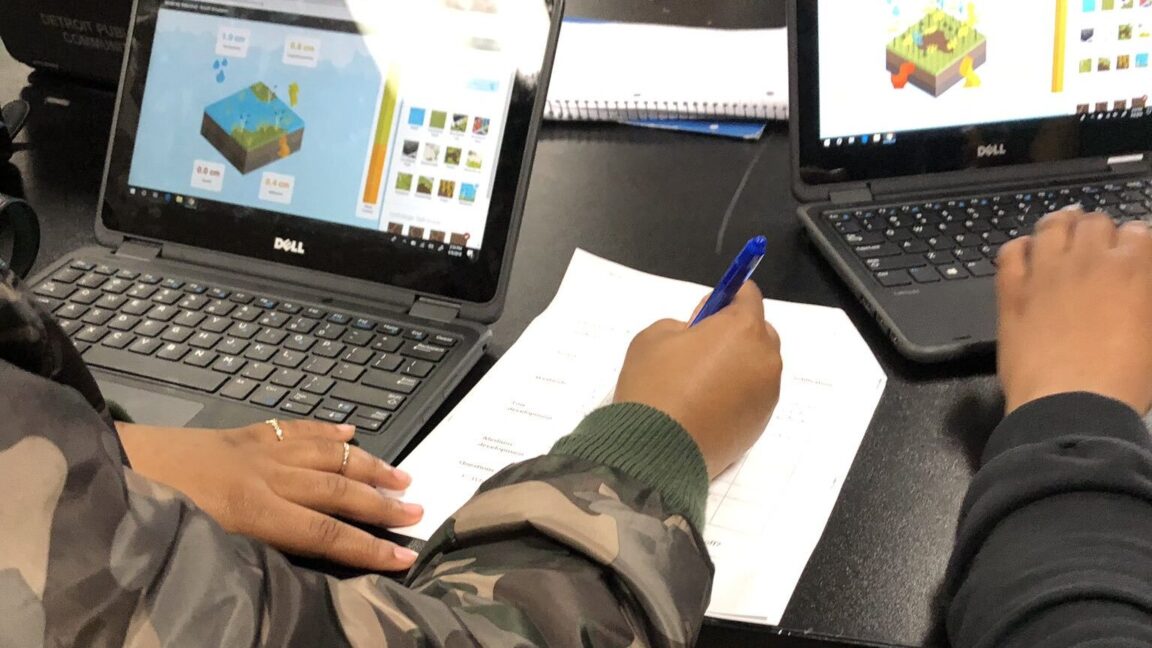
According to the Institute for Science + Math Education, barriers to implementing Next Generation Science Standards (NGSS) in classrooms include the limited availability of curriculum resources and the cost to districts in teachers’ time and funding to develop them (Institute for Science + Math Education, n.d.-a). The good news is that curriculum adaptation, the act of customizing universally applicable lesson plans and materials for use in one’s classroom, is proving to be an effective strategy to help teachers learn about NGSS while also fostering the ground-up development of an entire scope and sequence of K–12, peer-reviewed, NGSS-aligned units and instructional materials (Institute for Science + Math Education, n.d.-a).
As a middle school science teacher, I have found myself in the same bind many other science teachers face: I need to engage my students in NGSS-aligned lessons that are relevant to their lives and where they live. I wondered, “How can I create a low-cost, place-based, NGSS-aligned unit using activities from multiple curricula?” Last year, as a participant in a professional development program for Detroit-area teachers (Creating Great Lakes Stewards to Promote Clean Water and Healthy Watersheds, sponsored by Michigan Technological University), I set out to answer this question and to discover how to integrate resources from multiple curricula into a coherent storyline.
Introducing the unit
In my Detroit middle school science classroom, the last unit of the year is focused on water chemistry. I was uncertain how to weave resources from the district and the professional development program together until I reviewed a district resource titled “15 Recent Water Quality Issues, Threats in Michigan” and located an August 2014 Detroit flood videoclip (MLive, 2014). From these resources, I learned that the 2014 Detroit flood produced five inches of rain in one hour and resulted in 4.5 billion gallons of raw sewage! I decided to use the 2014 Detroit flood as an anchor phenomenon—a real-world event my students and I would use to focus and direct our learning.
Previously, in my work on a research project with Professor Brian Reiser of Northwestern University, I piloted an NGSS unit storyline about sound that I anchored using a video about how the sound from speakers can cause windows across the street to shake (Bryant, 2018). The video captivated my students’ attention, and I hoped the video of the Detroit flood would have a similar positive effect on student engagement.
I started the watershed unit with a pretest from the Michigan Science Teaching and Assessment Reform Curriculum (MI-STAR), with the goal of activating and assessing students’ prior knowledge. As I prepared the unit, I realized my initial driving question for the storyline, “How does rainfall cause streets to flood?”, was incorrectly framed; there were many interactions involved in explaining the flood phenomenon that the question would not capture. I reframed the question as “How do interactions between air, land, water, and living things relate to flood events?” and shared it with my students.
With the question in mind, students watched the video and completed a notice-think-wonder protocol designed to help them distinguish between their observations and interpretations. These were some student responses:
- I noticed it was raining hard.
- I think the sewer will be clogged so when it rained, the rain had nowhere to go.
- I wonder how much it rained and how the sewers were unclogged.
I planned to incorporate instructional strategies that supported students in planning and carrying out an investigation using their own questions. To accomplish this, I knew I had to shift the focus of my teaching from me asking questions to my students asking questions. I reached out to other science teachers during an NGSS chat on Twitter (#NGSSchat). Another science teacher suggested question formulation technique (QFT), a strategy in which students generate questions, categorize and improve them, and then select their top three questions to develop a driving questions board (See Figure 1).
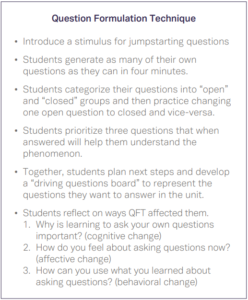
Figure 1. The steps for Question Formulation Technique. Adapted from “Steps of QFT” by The Right Question Institute, n.d. Retrieved from https://rightquestion.org/what-is-the-qft/.
Next, students drew initial models to capture their understanding of the beginning, middle, and end of the flood phenomenon and added “zoom in” bubbles between sun, rain, and land to capture unobservable features. Then, we had a class discussion about our models, decided the components we would keep, and added question marks for ideas about which we were unsure (see Figure 2).
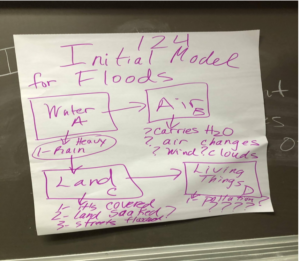
Figure 2. Our class consensus model.
Refining the model through an investigation
In this unit, my students were working toward mastering five NGSS standards (Next Generation Science Standards, n.d.):
- MS-PS1.1—Develop models to describe the atomic composition of simple molecules and extended structures.
- MS-PS1.4—Develop a model that predicts and describes changes in particle motion, temperature, and state of a pure substance when thermal energy is added or removed.
- MS-ESS2.4—Develop a model to describe the cycling of water through earth’s system driven by energy from the sun and the force of gravity.
- MS-ESS3.2—Analyze and interpret data on natural hazards to forecast future catastrophic events and inform the development of technologies to mitigate their effects.
- MS-ESS3.3—Apply scientific principles to design a method for monitoring and minimizing a human impact on the environment.
Using the Model Based Inquiry Unit template as a guide (Model-based inquiry – MBI template, n.d.), I identified performance expectations for each part of our model and the investigations that would ground the unit, including examining where flood water goes, the behavior of water itself, and what causes it to rain.
Lessons were framed by guiding questions which, when answered, would complete a bit of the flood phenomenon puzzle. For example, I asked my students, “Is water sticky?” When most students answered “No!” with emphasis, I decided to challenge their preconceptions with a demo involving immersing two dry pieces of paper towel in water and putting them together to make them stick. This simple demonstration of a phenomenon piqued student interest and gave them a reason to read articles and complete graphic organizers to learn more about the structure and properties of water.
Students further investigated the properties of water when they engaged in the Project Wet Water Olympics activity to predict and observe the interactions of water with different materials (Project WET, 2011). When I used this activity with students in the past, my objective was for students to learn facts about water. However, in the context of my NGSS storyline, I used the activity to build students’ conceptual understanding. As the unit progressed, I realized the activity also helped students develop background information they could retrieve later to understand absorption/infiltration of different land cover types. We also used a physical model of water to visualize stickiness and a graphic organizer on scale, proportion, and quantity to record observations of the macroscopic patterns to atomic-level structure. However, I missed opportunities to incorporate math concepts such as ratios (in molecular formulas) and large-scale calculations using exponents (number of molecules in a drop of water)—something I will improve on the next time I teach this unit.
After a few days of instruction, students returned to their initial models to make revisions. They used three sticky notes to record what they would add to the model, what they would take away, and what new questions they had (see Figure 3). We then added their new questions to the driving questions board.
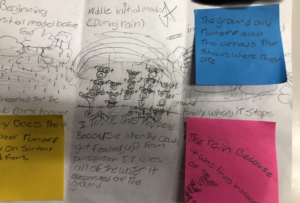
Figure 3. Example of a student-revised initial model.
Incorporating multiple models and tools
The next question we considered was, “How does heat affect the particle arrangement and motion in solids, liquids, and gases?” We used a virtual simulation, States of Matter (PhET, n.d.), and a worksheet from a unit by MI-STAR, “Water on the Move: The Water Cycle” (Michigan Science Teaching and Assessment Reform, n.d.), to support students to use their prior knowledge to deepen their understanding of the flood phenomenon. To further assist with sense making, students used a bead model with a pre/post-talk writing support tool following the simulation (Institute for Science + Math Education, n.d.-b). Using this combination of models provided students with opportunities to discuss the advantages and limitations of each.
I also accessed resources from the Michigan Environmental Education Curriculum Support and the Concord Consortium to demonstrate ways to improve their watershed models by implementing appropriate conservation practices. My students used “Water Moving Around the Earth,” “Energy Balance and Atmosphere,” “Radiant Energy,” and “What Affects Your Watershed?” from Innovative Technology in Science Inquiry (ITSI) for this lesson because along with engaging students in modeling, computational thinking, and real-time data acquisition, these resources also invited them to consider STEM careers (Concord Consortium, 2016–17a–d). I found that projecting these ITSI models on a screen allowed us to note the strengths and weaknesses of models as a class. To further deepen students’ understanding, when I use this resource again next year, I plan to ask students to construct additional partner models and write explanations about other related phenomena following the simulation.
Six weeks into the unit, students worked with partners to create an updated model including new evidence (see Figure 4). I then used the pretest assessment as a post-test to gauge the impact of instruction on students’ learning about parts A, B, and C of our classroom consensus model (see Figure 2). Although I sensed that students were near the point where they could transfer and apply their knowledge, I realized they struggled when trying to explain their thinking on an embedded assessment. My Twitter professional learning network recommended that next time, before I assess students’ understanding, I should use the Discussion Diamond writing scaffold provided by STEM Teaching Tools to help students clarify what must be true about all solids, liquids, and gases based on the various models they explored. The Discussion Diamond has triangular corners with a diamond in the middle. Each student has three minutes to think and respond to a question prompt in each corner. After they discuss their individual answers, they come to a consensus and write their response inside the diamond. I am looking forward to implementing this structured discussion tool with my students during my next enactment of this unit to see if it improves their performance on the embedded assessment.
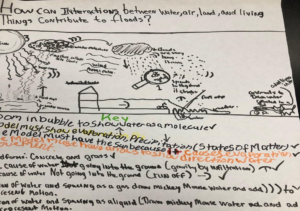
Figure 4. An updated model. Students worked with a partner to update their models to describe interactions between Earth’s spheres—A–water, B–air, and C–land. Notice the magnifying glass has been added to zoom into water structure and semi circles are used to represent particle speed and state of matter.
Closing the unit
To answer the question, “How does elevation combined with the force of gravity influence the flow of water?”, students constructed 3D watershed models, wrote explanations, and used interactive mapping software (ESRI, n.d.). Students were excited to type in their home addresses and observe changing elevation within their neighborhood.
As a final challenge to improve their watershed models, students used a runoff simulation to answer the question, “How does a 24-hour storm event affect the watershed?” (Stroud Water Research Center, 2019). The interactive runoff simulation allowed students to investigate how changing land cover, amount of rainfall, and soil texture affects where water goes when it rains. As they worked, students created a t-chart noting land uses that minimize water runoff and pollution, to help them decide which land cover they would pick for their watershed based on their results.
NGSS units are complex and require a variety of resources, collaboration, and pedagogical strategies.
Next steps
At the beginning of the unit, my students generated a list of related phenomena, including tornadoes, snow storms, tsunamis, hurricanes, hail storms, and earthquakes. Time constraints prevented us from circling back to these student ideas, but they could be used as stimuli to create scenarios for summative tasks. In the next iteration of this unit, it will be important to address why the sewers were clogged and how the problem was solved. I have already identified Project Wet activities to illustrate how demands on some treatment plants cause sewer overflows. I would also like students to consider more deeply how wetlands aid in flood prevention. In addition, I will modify the directions of the pre/post test, as many students did not represent states of matter using semicircles, nor water as a molecule. Next time, I will
explicitly ask them to do so.
NGSS units are complex and require a variety of resources, collaboration, and pedagogical strategies. Although my watershed unit did not satisfy every formal descriptor of an NGSS storyline unit, and there is much I want to improve in the future, my students were engaged in building and critiquing models of scientific phenomenon and they did make progress on mastering the disciplinary core ideas and cross-cutting concepts.
Before teachers attempt to build their own NGSS unit from scratch, I recommend spending time engaging with existing vetted NGSS curricula. Access to quality professional learning experiences, like the Learning While Teaching project, curiosity, extensive reading, and ongoing reflection are critical for teachers to create and sequence high quality three-dimensional NGSS units. Encouraged by my initial attempt at using an available collection of free or low-cost resources, I am exploring options to create additional place-based units and hope readers of this article will consider doing the same.
-
Discussion Diamond available at http://stemteachingtools.org/assets/landscapes/Protocolsv2_08.pdf
Model-based Inquiry Template available at https://sites.google.com/view/modelbasedinquiry/template/mbi-template?authuser=0
Water Kit by 3D Molecular Designs available at https://www.3dmoleculardesigns.com/Education-Products/Water-Kit.htm
-
Fink, S. & Baek, J. (2017, February). Supporting student understanding of watersheds by using multiple models to explore elevation. Science Scope, 40(6), 24–32.
Marcum-Dietrich, N., Kerlin, S., Staudt, C., & Daniels, M. (2018, February 1). Our watershed: Students use data and models to make a difference in their own school yard. The Science Teacher, 85(2), 39–46.
Michigan Environmental Education Curriculum Support. (2019). Lesson four: How does land use affect water quality? In Water Quality Overview [PDF]. Retrieved from https://www.michigan.gov/documents/deq/deq-exe-outreach-meecs-water-Intro_310329_7.pdf
Windschitl, M., Thompson, J.J., & Braaten, M.L. (2018). Ambitious science teaching. Massachusetts: Harvard Education Publishing Group.
Citation
Bryant, W. (2020). A recipe for planning an NGSS storyline: Curiosity, persistence, reflection and a library of resources. Kaleidoscope: Educator Voices and Perspectives, 6(2), 15–20.
